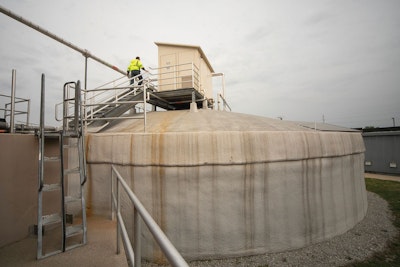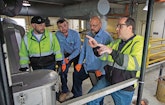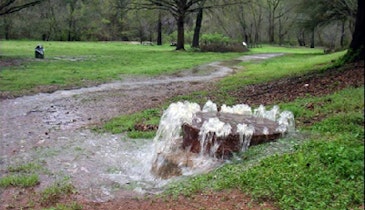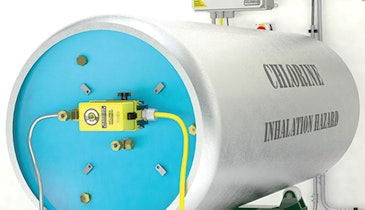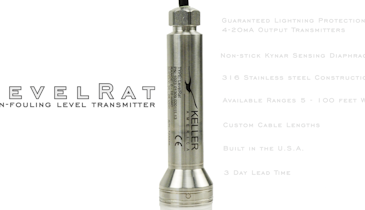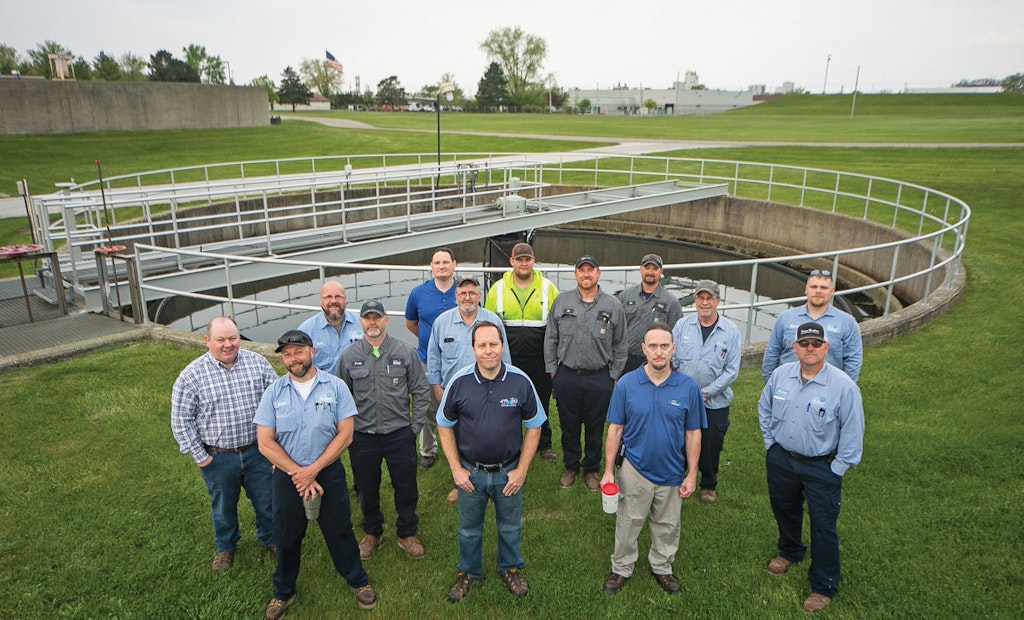
The staff at the City of Midland Water Reclamation Facility includes, from left, Ryan Ives, maintenance supervisor; Scott Clark, electrician; Kurt Bruske, operator mechanic; Craig Baumer, electrician; Tony Dancer, operator; Carl Minton, plant mechanic; Bruce Royce, operations manager; Jordan Rulapaugh, service person; Jon Gehringer, electrician; Kyle Shann, electrician; Tom Wiles, operator; Rick Wall, operator mechanic; Hunter Schneider, utilities maintenance; and Brandon Willman, utilities maintenance.
It’s not just the water coming through the sewer system that concerns Bruce Royce and his team at the Midland Water Reclamation Department.
Located in Central Michigan, Midland lies at the confluence of the Tittabawassee and Chippewa rivers, whose watersheds encompass a large share of the Lower Peninsula. The two meet downtown at a three-legged footbridge known as the Tridge.
“We are at a natural choke point of a very large drainage basin,” Royce observes. As a result, the city is more than usually susceptible to flooding during major rain events. Those floods have affected the Midland Water Reclamation Facility several times in relatively recent years.
It’s no accident that Royce, in addition to his Class A (highest) wastewater operator license, also holds Industrial Stormwater certification. In his 18 years with the city, Royce and his team have worked through significant floods, one involving an upstream dam failure in 2020.
Good preparation and an all-hands-on-deck team spirit have been essential in meeting those challenges. For this and other successes, Royce was named 2022 Operations Professional of the Year by the Michigan Water Environment Association.
Educator by training
Royce, a native of western Michigan, earned a bachelor’s degree in physical sciences, environmental science and education from Central Michigan University. After teaching in an adult and alternative education program for two years, he came upon an ad for a wastewater operator job in Midland.
“One of the preferred qualifications was a science degree,” he recalls. “The pay and benefits looked good, so I thought, let’s apply.” He placed in the top five on a city exam, received an interview, and upon being hired in 2005 saw a career path: “Within the first year I set my goal to obtain my Class A operator license as soon as possible.” He became general supervisor at the treatment facility in 2014, served as interim director of wastewater for seven months starting in December 2020, and in 2022 was promoted to plant manager.
The Midland plant (9 mgd design) runs two parallel treatment trains. Influent passes through a headworks building with center-flow 6 mm perforated plate screens (Hydro-Dyne Engineering) and grit settling chambers with reciprocating rakes (Ovivo). The flow then splits between the parallel trains with a two-stage trickling filter system engineered by McNamee, Porter and Seeley (Tetra Tech) with primary treatment followed by an oxidation ditch (same engineering firm).
Ferric chloride and polymer are added to aid in phosphorus removal. Final effluent is disinfected with gaseous chlorine and dechlorinated using sodium bisulfite before discharge to the Tittabawassee River.
Sludges are sent to two 500,000-gallon primary digesters and a 1-million-gallon secondary digester with a floating lid for biogas collection. The gas is compressed and sent to an on-site gas-to-energy facility, where it is blended with biogas from the city landfill. The mixture is burned in two 1.6 MW generator sets (Caterpillar) to produce electricity sold to the grid and to supply heat for the entire wastewater treatment process, including the digesters.
Class B biosolids are land-applied by a contractor. A belt filter press (Phoenix Process Equipment) is held in reserve to produce cake for landfilling in case land application is interrupted.
Dealing with floods
For decades, Midland has dealt with flooding that affects the collection system and the water reclamation facility. The city has 43 remote pump stations and about 200 miles of separated sanitary sewers.
In 2020, Royce spearheaded the city’s response to a 2018 Storm and Sanitary Sewer Report, leading to a $49.5 million flood mitigation program now in progress with the Moore and Bruggink consulting firm. That effort includes a campaign to disconnect household footing drains from the sewer system in two targeted neighborhoods covering roughly 375 homes. About 10,000 homes in older sections of the city remain connected.
The first major flood in Midland in 1986 affected the entire middle of the state, from Lake Michigan to Lake Huron. Another relatively widespread flood occurred in 1996. During a 2013 rain event a substantial rise in river levels was predicted. It didn’t actually happen, but city teams were prepared for it based on experience from the 1986 flood.
Two much more recent events tested Royce and his team. In June 2017 about 5 inches of rain over one week was followed by an overnight rain that brought 4.25 inches at the treatment plant and up to seven inches reported in some areas of town. That triggered flash flooding that struck from about midnight to 6 a.m. “A significant amount of rain hit our collection system very fast,” Royce recalls. “Everything was at capacity. Every pump station was running full tilt.”
At the plant, the inrush of water and the first flush of solids and trash plugged and disabled the headworks equipment. “There was a fountain from and underground rising well coming up out of the ground,” Royce recalls. “The flow was splitting and we had a river running down each side of the plant. The water was coming faster than we could possibly push it through.”
Royce instructed operator Tony Dancer to call in all available personnel, while he worked at opening all the bypasses in an effort to eliminate the overland flooding at the plant. He managed to divert the flow from the screenings building and into a 3 million-gallon underground storage tank, from which pumps lifted it to a 43.5 million-gallon aboveground basin.
“That way I could chlorinate it, knowing full well that we were going to have an SSO,” says Royce. “I tried to minimize impact to the environment and provide some relief so that when our electricians and mechanics arrived in the next hour or two they could start repairing equipment and getting it online.” By 4 a.m. the repairs were in progress; by 6 a.m. the overland flooding had stopped, and gradually the plant was brought back to normal high-flow operation.
Danger from a dam
The team’s cumulative experience with flooding came into play in 2020 when a private dam upstream on the Tittabawassee River failed during a 25-year rainfall. Six months earlier, the Midland County emergency coordinator had conducted a tabletop exercise for a catastrophic dam failure, and Midland had developed an action plan.
On May 18 the city received a report of an impending dam failure. It turned out to be a false alarm, but it gave Royce and his staff time to prepare to protect critical lift stations and make plans to power stations down as needed to keep them from short-circuiting when flooded and destroying the equipment inside.
“We knew about how many hours we had from the time a dam failed until the water hit the city,” Royce recalls. “We also knew the river level that would occur. The dam failure exercise showed that it would breach a 500-year flood level.”
The next morning an alert came of an actual dam failure. As the flood waters rose, about one-third of the city was evacuated. Royce’s team put the emergency plan into action and minimized damage to the lift stations. After the water peaked and subsided the next day, the plant team and contractors pumped down the system, made repairs to motors and other electrical equipment, and had essentially the entire system back in operation within 48 hours.
Credit to the team
Royce praises the facility staff members for their performance during the floods and for their generally excellent work in keeping the plant running efficiently. His team includes:
- Jared Driscoll, wastewater director
- Tom Wiles, Tammy Birchmeier, Mike Castillo, Austen Tyrer, Tony Dancer and Tim Reinke, operators
- Steve Smith, collections maintenance manager, and Ryan Ives, collections maintenance supervisor
- Craig Baumer, Jon Gehringer and Kyle Shann, electrical mechanical maintenance
- Chris Flemming and Carl Minton, plant mechanics, and Rick Wall, Kurt Bruske and Scott Clark, operator mechanics
- Justus Stalter, Shaun Lachcik, Hunter Schneider and Brandon Willman, utilities maintenance
- Jordan Rulapaugh and Megan Brawt, service personnel.
“My leadership philosophy is to develop buy-in, or ownership,” Royce says. “I want our team members to take responsibility and pride. I give them parameters and encourage them to think critically, make decisions for themselves, and try to answer their own questions.
“The plant operators are the ones who run the place. They work 75% of their time without supervision. I need them to be quality employees who have a high level of responsibility. I want them to think, ‘This is my plant.’
“I do not micromanage. I have told them all: If you have an idea or there is something you want to try, great. Don’t just come to me and say, ‘Hey, we should try this.’ Flesh it out. Give me the program and the data. Make an argument. Then if it’s reasonable, and if it’s within budget, we’ll try and implement it.”
Staffing challenges
Keeping a skilled and cohesive team on board is increasingly difficult: “It’s getting harder to find quality team members, even if it’s just having a Class B CDL and running a flusher truck. We need quality employees, and we’re struggling to find them. Each job posting sees fewer applications.”
Royce places high priority on training his team and passing along the knowledge he has acquired from nearly two decades with the city. In the bigger picture of training, he has assisted with regional training classes for the Michigan WEA.
He also serves on the Water Environment Technology Program Advisory Committee at Delta College in nearby University Center. That program delivers operator training, and the advisory committee works with employers to ensure that the program includes the right content and meets professionals’ expectations. It also helps operators arrange for the hands-on experience their certifications require.
Royce’s goal is to develop operators’ skills and help them to be successful: “If that unfortunately means I train somebody well and they move on to be a manager elsewhere, so be it. They’re advancing in their careers, and I see that as a success on my part.”
“I wouldn’t have been nominated as Operations Professional of the Year if not for the great crew of people who work with me. I believe in helping them to feel an essential part of the team by recognizing and making use of their achievements, skills and abilities. They are essential to my success.”
